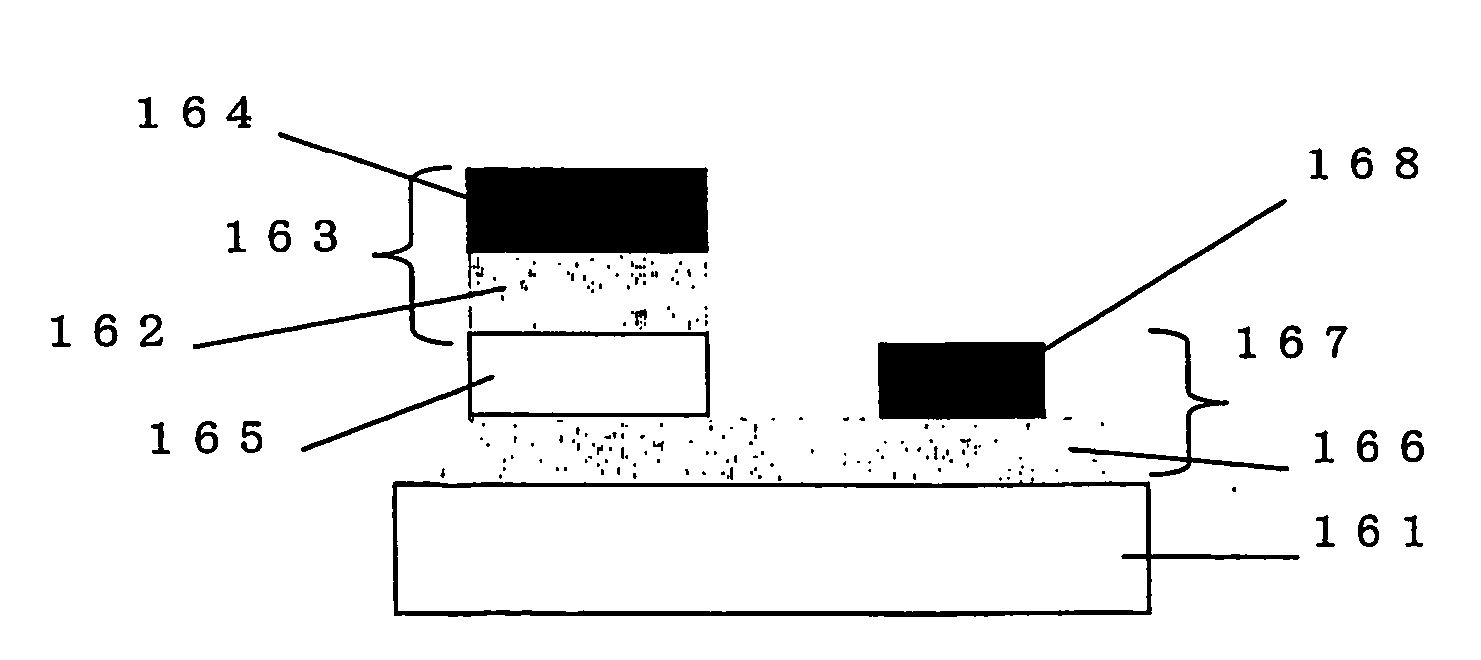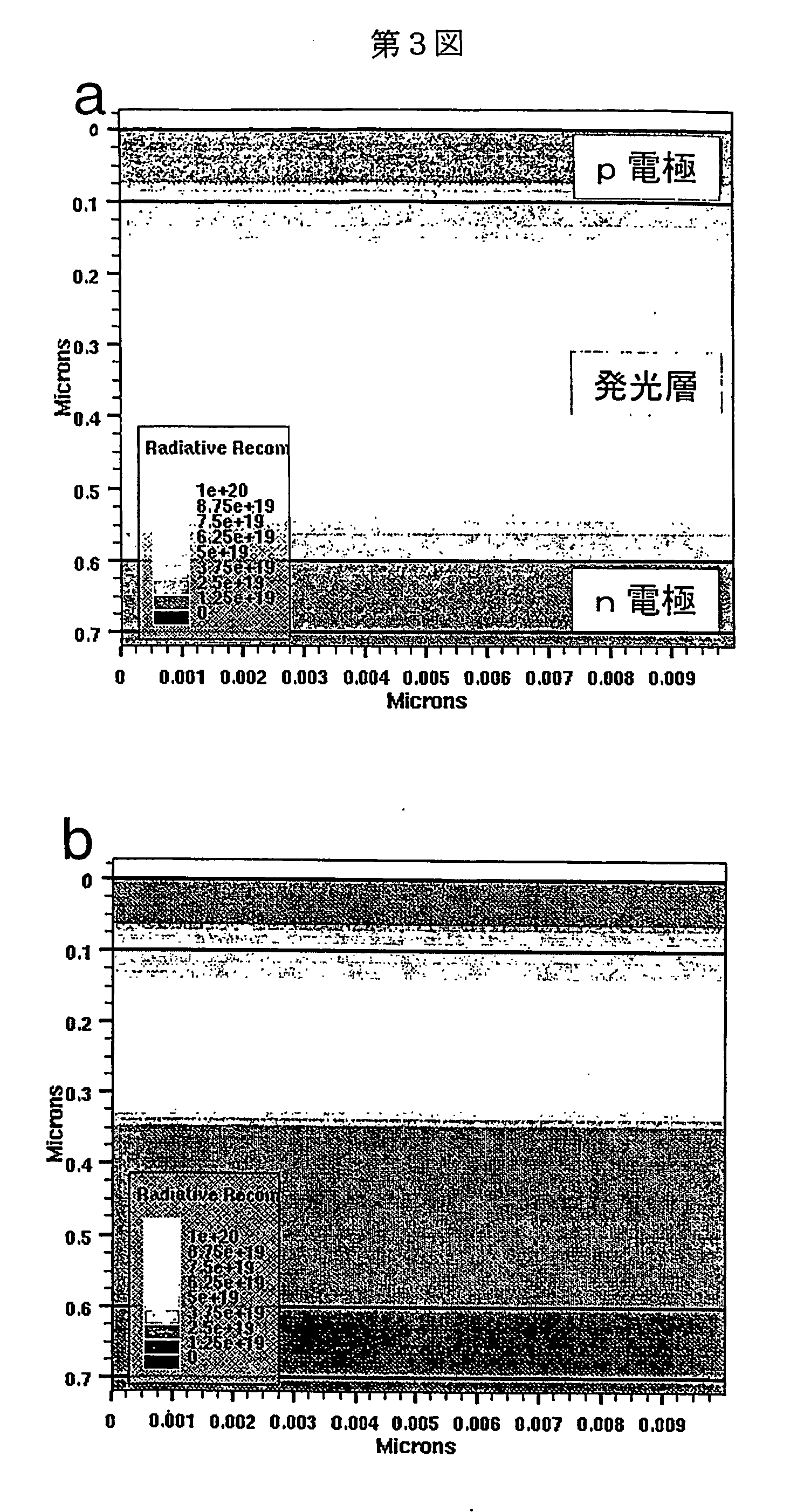Light-emitting diode
a light-emitting diode and light-emitting element technology, applied in the direction of lasers, semiconductor lasers, solid-state devices, etc., can solve the problems of reducing luminous efficiency, reducing the mobility of the diode, and reducing the luminous efficiency of the diode, so as to reduce the defect density and reduce the luminous efficiency. , the effect of high mobility
- Summary
- Abstract
- Description
- Claims
- Application Information
AI Technical Summary
Benefits of technology
Problems solved by technology
Method used
Image
Examples
example 1
[0119] ZnSe was selected as an ambipolar inorganic semiconductor forming a light-emitting layer. A GaAs (100) monocrystalline wafer (carrier density: 1×1018 / cm3) doped n-type was immersed in a so-called piranha solution (mixed solution of H2, O2, H2OS4) to remove an oxide layer on a surface thereof. This was quickly introduced as a substrate for film formation into a molecular beam epitaxy (MBE) vacuum device for film formation (manufactured by Eikoh Engineering, ultimate vacuum: 5×10−10 Torr), and fixed thereto. Then, a temperature of the substrate was raised to 500° C., and it was confirmed by looking a reflection high energy electron diffraction image (RHEED) that a clean and flat surface was exposed. Further, the substrate temperature was dropped to 400° C., and a molecular beam of each component was emitted from a Zn cell and an Se cell and applied to the GaAs (100) substrate, thereby forming a ZnSe thin film at 2 μmt.
[0120] Next, carrier mobility in the thin film was measured...
example 2
[0122] As in Example 1, an n-GaAs (100) monocrystalline wafer was immersed in a piranha solution, and introduced and fixed in an MBE vacuum device for film formation. A temperature was raised to 500° C., and it was confirmed by looking a reflection high energy electron diffraction image (RHEED) that a clean and flat surface was exposed. Then, the substrate temperature was dropped to 400° C., and a molecular beam of each component was emitted from a Zn cell, an Se cell and an Al cell, and applied to the n-GaAs (100) substrate, thereby forming a film of an n-type ZnSe doped with Al at 2 μmt. In other words, an n-electrode having an n-GaAs / n-ZnSe structure was formed. Next, a ZnSe layer is stacked on this layer at 200 nmt to produce a light-emitting layer. Further, a molecular beam of an N atom in a radical state was applied onto the substrate together with the molecular beams of Zn and Se by use of an ion source manufactured by Oxford Applied Research Corporation, and a film of p-ZnSe...
example 3
[0133] In Example 2, a stacking order was changed in the following manner. Example 3 will be described with reference to FIG. 10. A p-ZnSe film 136 doped with N was formed at 2 μm on a non-doped p-GaAs (100) substrate 131. Next, part of the p-ZnSe substrate 136 was covered with a mask, and a ZnSe layer 135 was stacked at 200 nm on the remainder, thereby producing a light-emitting layer. Moreover, after an Mg film 132 was deposited on the light-emitting layer 135, the Mg film 132 was covered with an Au film 134, and an n-electrode 133 was thus produced as an Mg / Au laminated film. Next, the mask covering a surface of p-ZnSe was removed, and a Pd film 138 was vapor-deposited on the surface, and then an Au film 139 was further deposited thereon, thereby creating a p-ZnSe / Pd / Au structure as a p-electrode 137. When a voltage of 10 V was applied across the electrodes, an emission spectrum similar to that of curve (a) in FIG. 8 was obtained.
[0134] In addition, when a Cl-doped n-ZnSe / Mg / Au ...
PUM
 Login to View More
Login to View More Abstract
Description
Claims
Application Information
 Login to View More
Login to View More - R&D
- Intellectual Property
- Life Sciences
- Materials
- Tech Scout
- Unparalleled Data Quality
- Higher Quality Content
- 60% Fewer Hallucinations
Browse by: Latest US Patents, China's latest patents, Technical Efficacy Thesaurus, Application Domain, Technology Topic, Popular Technical Reports.
© 2025 PatSnap. All rights reserved.Legal|Privacy policy|Modern Slavery Act Transparency Statement|Sitemap|About US| Contact US: help@patsnap.com



